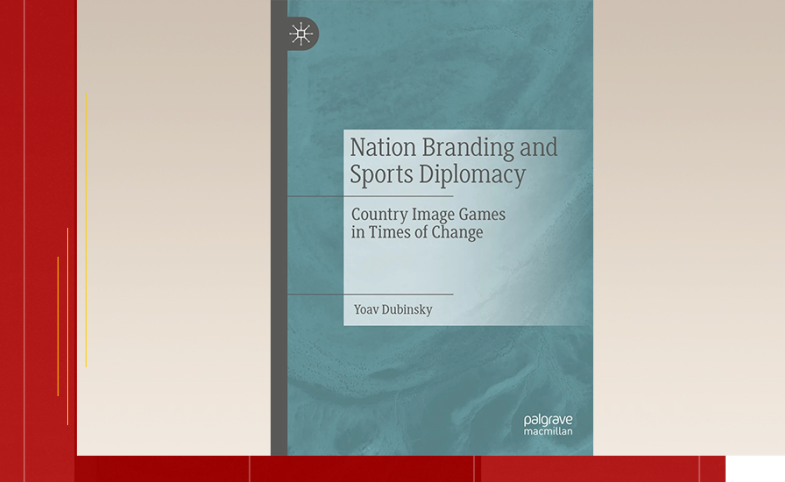
Meet the Author: Yoav Dubinsky

Dr. Yoav Dubinsky is an Instructor of Sports Business in the Lundquist College of Business at the University of Oregon, where he teaches courses on sports, business and society and on marketing. He is a sports researcher and a former sports journalist with over 15 years of experience covering and researching sports around the world.
His recent book, Nation Branding and Sports Diplomacy: Country Image Games in Times of Change, discusses the role of sports in nation branding and public diplomacy from 2020 to 2022, as the world experienced a global pandemic, as well as health, economic, social, and political crises.
How did you first get the idea to write this book?
I have been covering or researching international sports for around 20 years, including four Olympic Games and hundreds of sports events around the world. So, I have been flirting with writing an academic book about nation branding, public diplomacy, and global sports for a while, but I have been struggling to define to myself what exactly the book will be about and how to write it so it will not become irrelevant within a year or two. I think the COVID-19 pandemic played a key role. First of all, the world changed, and sports played a role in that. The NBA stopping was a significant moment in the United States and started a domino effect of other sports canceling or postponing their seasons, and of course postponing the Olympic Games by a year was unprecedented. During the years of the pandemic, I (a) tried to keep myself busy and perhaps also distracted by burring myself in research and writing manuscripts and (b) conducted research in Japan during the Tokyo 2020 Olympic Games. In doing both, my focus was not just on the global health crisis, but on social, political, and economic implications and how they manifested through sports. So, seeing how the world of sports changed, and being an active scholar on these topics, led me into framing a starting of the beginning of 2020, just before the outbreak of COVID-19. By the end of 2022, most sports organizations had relaxed their COVID-19 restrictions, and with the FIFA World Cup in Qatar held in November and December, the end of 2022 felt like a right ending point. So once I had that time framework, then I could decide on specific chapters and what exactly through these years I wanted to focus on, to sharpen my theoretical framework around how this period is (a) unique from others as the world changes, but (b) is also similar in the sense of countries, places, and communities still using sports for nation branding and public diplomacy, but through different methods. And that became the main statement of the book.
Can you describe a recent success story in sports diplomacy?
We should define what success is because, in the realm of nation branding and public diplomacy, there are many direct and indirect outcomes, and success can be defined differently based on the eyes of the beholder. For example, the Qatar 2022 FIFA World Cup can be seen as a complete public diplomacy disaster from a Western standpoint, scrutinizing Qatar for sportswashing and laundering the country’s image from human rights violations related to workers’ rights, gender inequality, anti-LGBTQ laws, unsustainable public spending, etc. On the other hand, the Qataris, a small country in the Emirates with no significant military influence, can brag about using a football tournament to completely renovate and modernize the country, hosting the biggest event the Arab and Muslim world has ever did and positioning itself as a regional leader, going through social reform through abolishing the kafala system, and overall creating a safe environment for fans through the competitions without incidents of violence or hooliganism. So, the question of success is much contested. I use the work of Professor Nick Cull in much of my work, when emphasizing the significance of authenticity and that good public diplomacy must rely on ethical policies. In that sense, when looking at how Australia and New Zealand hosted the 2023 FIFA Women’s World Cup, both host countries put much emphasis on gender equality, on sustainability, and on Indigenous and native culture. The tournament broke attendance and viewership records, and both hosts were mostly portrayed as diverse and inclusive, which could be classified as a success story.
Can you overview your research into sport-tech diplomacy and its evolution?
I was born and raised in Tel-Aviv, Israel, and my PhD dissertation at the University of Tennessee, Knoxville, is titled, “Israel’s use of sports for nation branding and public diplomacy.” International politics have often overshadowed Israel’s participation in sports, including through boycotts, protests, exclusions and even terrorism in the Munich 1972 Olympic Games. The polarizing Israeli-Arab and Israeli-Palestinian disputes often limit Israel’s ability to maximize sports as a soft power tool. As part of the interviews I conducted, I was exposed to different branding attempts of Israel as a start-up nation, by focusing on technology and on a history of creativity and adaptation of Israeli and Jewish people. That branding of Israel as a technological powerhouse and an innovative hub, is bypassing message to a polarizing dispute, which does not force foreign publics and stakeholders to choose a side, can creates point of interests for collaboration. While Israel is a very divided society, Israeli governments, the private sections, and Israeli citizens see value in that message. In the context of sports, which means a growing industry of sports-related technologies – sport-tech – which are used in some of the biggest sports leagues and organizations around the world or bought by major tech corporations. So, through these business relationships of Israeli sport-tech companies working with the biggest sports brand in the world or sold to major global corporations, this form of globalization of people, products, and ideas, opens all kind of international collaborations and opportunities with Israel. The Israeli government and the municipality of Tel-Aviv are encouraging tech-startups including in the realm of sports; the Israeli sport-tech ecosystem is growing and diversifying; Israeli sports clubs and organizations are adopting the Israeli sport-tech industry; and Israeli top-athletes have bcome entrepreneurs and invested in Israeli sport-tech companies. So, through traditional public diplomacy, from corporate-diplomacy, and from people-to-people diplomacy, this message of focusing on sport-tech became authentic. This is where I started to use the concept. I applied it further when discussing the case of Japan and the Tokyo 2020 Olympic Games.
Did anything surprise you in researching and writing the book?
As I dived deeper into the research and writing, I started to ask myself more questions and became more ambivalent about the use of sports for nation branding and public diplomacy. That corresponds with my answer to the first question about the success of sports diplomacy. For example, take Title IX, the Amendment to the Education Law from 1972 that prohibits discrimination in federally funded educational institutions based on sex. One of the chapters focuses on public diplomacy amid the 50 year anniversary of the legislation. Through the lens of sports, that led to significant investments in women’s sports. Over ten times more girls participate in high school sports than in the 1970s; in college sports, this means equaling opportunities through a number of scholarships, facilities, training, and medical access, which leads to the development of elite American athletes who shine in Olympic Games and world championships in track and field, swimming, soccer, basketball, etc. So, on the one hand, this is a great and authentic outcome and a reason for celebrating America as diverse and inclusive, forming collaboration with other countries through international student athletes, or creating official sports diplomacy programs by the U.S. Department of State related to women’s sports. Yet, on the other hand, by celebrating Title IX, the U.S. continues to celebrate a sports pyramid that is rejected around the world – of student-athletes generating billions without being allowed to receive a salary. A system that heavily relies on African American athletes and on American football, where athletes risk concussions and brain damage and has been scrutinized in the U.S. by critical race scholars as “The New Plantation.” So, is that sports-washing? Using Title IX as a way to justify the ethics behind the American collegiate sports? Or does sports-washing only apply to non-democratic countries? Does sportswashing apply to the Commonwealth Games as a colonialist and imperialist initiative by Great Britain? Is the Super Bowl a celebration not just of American consumption, but through nationalistic traditions normalizes American militarism? And is the use of "whataboutism" a legitimate tactic to deflect negative attention? So, through doing research and writing this book, these kinds of questions that raise ambivalence, kept coming up almost in every chapter. Yet, life is complex, and at time might be self-contradicting, and the world of sports reflects that.
Why is Nation Branding and Sports Diplomacy an important book for students of public diplomacy?
Traditional scholarship on sports and diplomacy usually comes back to the Berlin 1936 Olympic Games held under Nazi Germany, the boycotts of the 1980 and 1984 Olympic Games, ping pong diplomacy between USA and China, etc. The world has changed and keeps changing. There is ample research on sports and international relations, or sports and soft power, but the distinctive field of sports diplomacy is just starting to get recognition. A few of the pioneers are Dr. Stuart Murray and Dr. Simon Rofe, and I hope that my work builds on theirs and takes the discussion forward. All the examples I mentioned are discussed in the book, but the focus is on 2020, 2021, and 2022, so it is much more contemporary and relevant. The main argument I make through the book is that while the use of sports for nation branding and public diplomacy is not new, global changes require countries to adapt and change the tactics of how to do so. For students, the book gives a solid theoretical background on the field and historical development that goes back to Ancient Greece, along with focusing on practical uses in different case studies, dives into the most current and relevant social issues that manifest through sports and opens them to the different ways sports is used in different countries trying to improve their image and achieve their goals. The book also prepares students for future changes the world will be going through, whether through technology, or climate change, or more geopolitical clashes. By reading the book or using it as part of a course syllabus on diplomacy or global sports, students gain better theoretical and practical knowledge on how sports has been used for place branding and public diplomacy and can be better prepared to apply that and be involved in shaping the world as it continues to change. So, as I state at the end of the book, as long as people will walk on this planet, they will also run, and compete who does that faster, and their communities and countries will continue to use that to achieve their social, political, and economic goals. And that is not going to change.
Visit CPD's Online Library
Explore CPD's vast online database featuring the latest books, articles, speeches and information on international organizations dedicated to public diplomacy.
Popular Blogs
-
November 3
-
November 5
-
November 13
-
November 25
-
November 17







